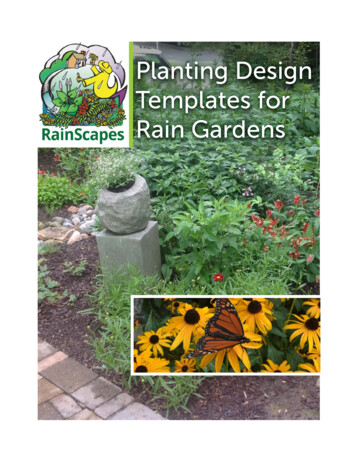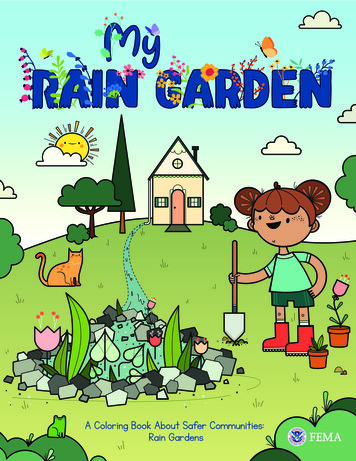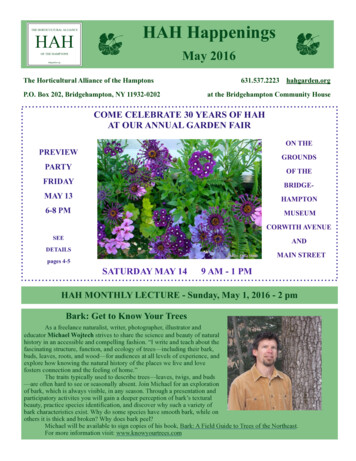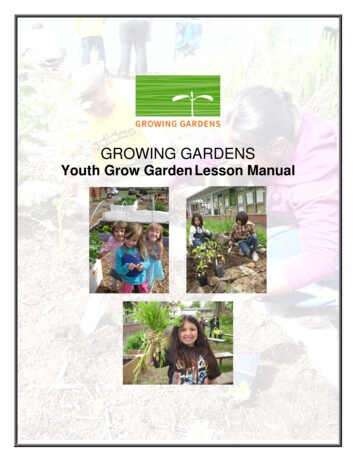
Transcription
Effects of Rain Gardens on the Quality of Water inthe Minneapolis–St. Paul Metropolitan Area ofMinnesota, 2002-04Scientific Investigations Report 2005-5189Prepared in cooperation with the Metropolitan Council of the Twin CitiesU.S. Department of the InteriorU.S. Geological Survey
Cover: Photograph showing rain-garden site at Lakeville, Minnesota, September 2004.(All photographs in this report were taken by U.S. Geological Survey employees.)
Effects of Rain Gardens on the Quality ofWater in the Minneapolis–St. PaulMetropolitan Area of Minnesota, 2002-04By Lan H. TornesScientific Investigations Report 2005-5189Prepared in cooperation with the Metropolitan Council of the Twin CitiesU.S. Department of the InteriorU.S. Geological Survey
U.S. Department of the InteriorGale A. Norton, SecretaryU.S. Geological SurveyP. Patrick Leahy, Acting DirectorUse of trade, product, or firm names in this report is for identification purposes only and does not constituteendorsement by the U.S. Geological Survey.Mounds View, Minnesota, 2005For additional information write to:U.S. Geological SurveyDirector, USGS Water Science Center of Minnesota2280 Woodale DriveMounds View, MN 55112http://mn.water.usgs.gov/For more information about the USGS and its products:Telephone: 1-888-ASK-USGSWorld Wide Web: http://www.usgs.gov/Although this report is in the public domain, permission must be secured from the individual copyright ownersto reproduce any copyrighted materials contained within this report.Scientific Investigations Report 2005-5189
iiiContentsAbstract. 1Introduction. 1Purpose and Scope. 2Acknowledgments. 3Description of Study Sites. 3Methods. 10Water Quality at Rain-Garden Sites. 11Chanhassen. 12Hugo . . 12Lakeville. 13Minnetonka. 13Woodbury. 15Effects of Rain Gardens on Water Quality. 15Implications of Results. 18Summary. 21Selected References. 22FiguresFigure 1.Figure 2.Figure 3.Figure 4.Figure 5.Figure 6.Figure 7.Figure 8.Figure 9.Figure 10.Schematic diagram of expected processes and monitoring points of a rain garden. 2Location of rain-garden sampling sites and percentage of clay in soils in the MinneapolisSt. Paul metropolitan area of Minnesota. 4Rain-garden configuration at Chanhassen, Minnesota. 6Rain-garden configuration at Hugo, Minnesota. . 8Rain-garden configuration at Lakeville, Minnesota. . 9Rain-garden configuration at Minnetonka, Minnesota. 10Rain-garden configuration at Woodbury, Minnesota. . 11Distribution of specific conductance and phosphorus, chloride, and suspended-solidsconcentration at each of the five rain-garden sites sampled in the Minneapolis-St. Paulmetropolitan area of Minnesota, 2004-04. 16Distribution of specific conductance of water samples collected from inflow and raingarden lysimeter and well at each of the five sites sampled in the Minneapolis-St. Paulmetropolitan area of Minnesota, 2002-04. 19Change in chloride, nitrite plus nitrate nitrogen filtered, and total phosphorus concentrationat the Hugo and Woodbury rain-garden sites in the Minneapolis-St. Paul metropolitanarea of Minnesota, 2002-04. 20
ivTablesTable 1.Table 2.Table 3.Table 4.Table 5.Table 6.Table 7.Table 8.Rain-garden sites sampled in the Minneapolis - St. Paul metropolitan area of Minnesota. 5Lithologic log of wells installed at rain-garden sites in the Minneapolis - St. Paulmetropolitan area of Minnesota. 7Median values of selected physical properties, chemical constituents, and nutrientspecies of water from the rain-garden site in Chanhassen, Minnesota, 2002-04. 12Median values of selected physical properties, chemical constituents, and nutrientspecies of water from the rain-garden site in Hugo, Minnesota, 2002-04. 13Median values of selected physical properties, chemical constituents, and nutrientspecies of water from the rain-garden site in Lakeville, Minnesota, 2002-04 . 14Median values of selected physical properties, chemical constituents, and nutrientspecies of water from the rain-garden site in Minnetonka, Minnesota, 2002-04. 14Median values of selected physical properties, chemical constituents, and nutrientspecies of water from the rain-garden site in Woodbury, Minnesota, 2002-04. 15Median specific-conductance value and chloride concentration at each of the fiverain-garden sites in the Minneapolis-St. Paul metropolitan area of Minnesota, 2004 . 18Conversion Factors, Datums, and Abbreviated Water-Quality UnitsMultiplyByTo obtaininch (in.)foot (ft)mile (mi)square mile (mi2)2.540.30481.6092.590centimeter (cm)meter (m)kilometer (km)square kilometer (km2)Water temperature is reported in degrees Celsius ( C), which can be converted to degrees Fahrenheit ( F) byusing the following equation: F (1.8 C) 32.Vertical coordinate information is referenced to the North American Vertical Datum of 1988 (NAVD 88).Horizontal coordinate information is referenced to the North American Datum of 1927 (NAD 27).Chemical concentration is reported only in metric units. Chemical concentration is reported in milligrams perliter (mg/L), which is a unit expressing the mass of solute (milligrams) per unit volume (liter) of water. Forconcentrations less than 7,000 milligrams per liter, the numerical value is about the same as for concentrationsin parts per million. Specific conductance is reported in microsiemens per centimeter at 25 degrees Celsius(µS/cm).
Effects of Rain Gardens on the Quality of Water in theMinneapolis–St. Paul Metropolitan Area of Minnesota,2002-04By Lan H. TornesAbstractIntroductionRain gardens are a popular method of managing runoffwhile attempting to provide aesthetic and environmental benefits. Five rain-garden sites in the Minneapolis – Saint Paulmetropolitan area of Minnesota were instrumented to evaluatethe effects of this water-management system on surface andsubsurface water quality. Most of these sites were in suburbanlocations and frequently in newer developments. Becauseof this they were affected by changing hydrology during thecourse of this study.Less-than-normal precipitation during much of the studymay have resulted in samples that may not be representative ofnormal conditions. However, the resulting data indicate thatproperly designed rain gardens enhance infiltration and canreduce concentrations of dissolved ions relative to backgroundconditions.The runoff events in one rain garden and several runoffevents in the other rain gardens produced no sampled overflow during this study because the gardens captured all ofthe inflow, which subsequently infiltrated beneath the landsurface, evaporated, or transpired through garden vegetation.Where measured, overflow had reduced concentrations ofsuspended solids and most nutrient species associated withparticulate material, as compared to inflow. Many of thesematerials settle to the bottom of the rain garden, and somenutrients may be assimilated by the plant community.Site design, including capacity relative to drainage areaand soil permeability, is an important consideration in theefficiency of rain-garden operation. Vegetation type likelyaffects the infiltration capacity, nutrient uptake, and evapotranspiration of a rain garden and probably the resulting waterquality. The long-term efficiency of rain gardens is difficult todetermine from the results of this study because most are stillevolving and maturing in relation to their hydrologic, biologic,and chemical setting. Many resource managers have questioned what long-term maintenance will be needed to keeprain gardens operating effectively. Additional or continuedstudies could address many of these concerns.Several means have been used to deal with storm-waterrunoff in urban areas. Traditional systems of curbs, gutters,and storm drains carry storm-water runoff directly to localstreams and rivers without any bioretention, filtering, processing, or attenuation of runoff. This direct runoff can result inerosion and delivery of sediment and nutrients to receivingwaters. Catch basins allow sediment to settle and retain nutrients that reduce the amount of material transported to nearbystreams and lakes. Although effective at attenuating runoffand suspended solids, they often create a hazard and can createbreeding grounds for mosquitoes and other pests.Rain gardens are becoming important landscape tools forwater managers and land-use planners. These retention basinsprovide water storage and an area for infiltration of stormwater runoff while providing attractive landscaping. Raingardens are designed to retain runoff and encourage infiltrationto ground water. Retention encourages uptake and biodegradation of compounds that may be present in the runoff. Theassumption of rain-garden design is that sediment, nutrient,and other chemical removal occurs as the runoff comes incontact with the soil, bacteria, and roots of shrubs or othervegetation within the rain garden. It also is assumed that thisprocess results in improved surface-water overflow quality,and improved quality and amount of ground water as a resultof infiltration.Rain gardens are being installed around the United States(Rain Garden Network, 2005), including in several communities around the Minneapolis-St. Paul metropolitan area of Minnesota. Although data have been collected from some sites,few published studies document effects of the rain gardens onthe quality of surface and ground water. To help address thisneed for information, a study was done by the U.S. GeologicalSurvey (USGS) in cooperation with the Metropolitan Councilof the Twin Cities, Department of Environmental Services,during 2002-04. The objective of the study was to describethe quality of water as it flowed into and through rain gardensfollowing runoff events.The expected processes that occur in rain gardens and anidealized schematic diagram of typical site instrumentationare shown in figure 1. Runoff water is directed into the rain
Effects of Rain Gardens on the Quality of Water in the Minneapolis-St. Paul Metropolitan Area of Minnesota, 2002-04%VAPOTRANSPIRATION,YSIMETER7ELL)NFLOW SAMPLER,YSIMETER/VERFLOW SAMPLER7ELL2AIN GARDEN4EMPORARY PONDING)NFILTRATION7ATER TABLE'ROUND WATER.OT TO SCALEFigure 1.Schematic diagram of expected processes and monitoring points of a rain garden.garden through storm drainage and subsequently allowed topond temporarily until water can infiltrate into the ground and(or) be taken up by the garden vegetation. Rain gardens aredesigned to overflow during large runoff events with a specified recurrence interval. Retained water undergoes a varietyof biotic or abiotic processes that include uptake by vegetationwith subsequent transpiration, evaporation, and infiltration.Sedimentation and biological transformation also removesuspended solids, nutrients, and other contaminants that couldbe detrimental to receiving waters.Purpose and ScopeThis report discusses the results from sampling rain-garden sites located throughout the Minneapolis-St. Paul metropolitan area during June 2002 through October 2004. Theamount of precipitation, the volume of inflow and overflow,and the amount of infiltration and other losses were not measured and were not considered in this report. Sources of waterto the rain gardens were evaluated only qualitatively becausemost sites had relatively flat contributing areas that may havesporadically added to the inflow.Sampling focused primarily on determining the concentration of a few selected constituents considered to be indicative of runoff including suspended solids (particulate materialcarried in suspension by flowing water, also called residue,total at 105 degrees Celsius, suspended), nitrogen, phospho-rus, chloride, and gross measures of dissolved constituents.Although the changes in mass transported throughout thesystem relative to sources were not measured, the data provideinitial information to evaluate measured concentrations incomponents of the water system in a rain garden that weresampled and determine how they interrelate at each of thesites sampled. Other important factors including precipitation characteristics, antecedent conditions, and flow volumesfrom which to compute loads were not measured. Longduration storms that exceeded the capacity of the automaticsamplers were not adequately sampled. Other factors thatcould contribute to a better understanding of the systemsincluding delineation of drainage areas, contributing drainageareas, and detailed information on land-use characteristics alsowere beyond the scope of this study. Determining how thesesamples relate to the existing climate or changing climate,changes in land use, and other factors also was beyond thescope of this report.Results in this report will improve understanding aboutthe fate of chemical constituents transported to rain gardensin runoff and can be used by water managers and land-useplanners to better understand the environmental impacts andeffectiveness of rain gardens in protecting water quality. Thiscan lead to improved designs and enhanced protection forsurface and ground water. Findings about the significance oflocal site conditions, such as soil texture and permeability, willallow for improved rain-garden design that more effectively
Introduction treats storm-water runoff. Results should be transferable toother areas of the nation.AcknowledgmentsThe USGS gratefully acknowledges the MetropolitanCouncil of the Twin Cities, Department of EnvironmentalServices, who supported and helped design this study. Gratitude also is extended to all of the local units of government,developers, and landowners who assisted with installationand allowed continued access to these sites. The followingcompanies provided maps of rain-garden design that wereused to sketch simplified diagrams of sites shown in figures 3,4, 5, and 7, respectively: Bonestroo, Rosene, Anderlick, andAssociates; Emmons and Olivier Resources, Inc.; WestwoodProfessional Resources; and Barr Engineering.Description of Study SitesThe Minneapolis-St. Paul metropolitan area of Minnesotais situated on relatively flat to gently rolling land that wasmostly prairie before settlement. Relief is much greater nearthe rivers and streams that cross the area. Most of the area hasan altitude of about 1,000 ft or less. The rain-garden sites thatwere studied range in altitude from about 925 to more than1,000 ft.Five rain-garden sampling sites were selected withthe input from the Metropolitan Council of EnvironmentalServices and other interested stakeholders. The sites represent a wide range of hydrologic and land-use conditions thatalso represent a range of impervious surface conditions thatincluded parking lots, driveways, walkways, and roofs. Therain gardens also may receive runoff from grassy areas including athletic fields and lawns.The five sites (fig. 2) are located in the communities ofChanhassen, Hugo, Lakeville, Minnetonka, and Woodbury.The sites are distributed across an area of nearly 4,000 mi2within the seven-county Minneapolis–St. Paul metropolitanarea. The percentage of clay in the uppermost 5 ft of the soilprofile (fig. 2) was estimated from the State Soil Geographic(STATSGO) data for Minnesota by averaging the percentageof clay in mapped units of the soil profile. The STATSGO dataset is “ a digital general soil association map developed bythe National Cooperative Soil Survey. It consists of a broadbased inventory of soils areas that occur in a repeatable patternon the landscape and that can be cartographically shown atthe scale mapped. The soil maps for STATSGO are compiledby generalizing more detailed soil survey maps. Where moredetailed soil survey maps are not available, data on geology,topography, vegetation, and climate are assembled, togetherwith Land Remote Sensing Satellite (LANDSAT) images.Soils of like areas are studied, and the probable classificationand extent of the soils are determined.” (U.S. Department ofAgriculture, 2005).The sampling sites at each of the rain gardens sampledfor this study are listed in table 1. Also included is information, such as site identifier, that would be useful in locatingadditional information about these sites and the actual datathat are currently (2005) available.The climate across the area ranges from relatively warmerin the southwest to relatively cooler in the northeast. However, these long-term climate patterns often are confounded byweather systems that have local effects.Climate conditions in the area are relatively uniform.Normal mean monthly temperatures at the Minneapolis -St.Paul International Airport (1971-2000) vary from 70.6 F(August) to 13.1 F (January) and average 45.4 F annually.These normal means are slightly higher in the south and westand lower in the north and east. Inner-city areas are slightlywarmer than outlying areas at all times of the year (MinnesotaDepartment of Natural Resources, 2005a).Seasonal variability in precipitation also occurs in thearea. Nearly two-thirds of normal mean annual precipitationfalls during the growing season from May through Septemberand only 8 percent of the normal mean annual precipitationfalls in the winter (December through February). Normalannual precipitation varies across the area from about 29 to30 in. and increases from the southwest to the northeast. Thelowest normal mean monthly precipitation occurs in August(Minnesota Department of Natural Resources, 2005b).During parts of this study, precipitation was less than normally would be expected. This resulted in collection of fewersamples than were anticipated during certain seasons.Climatic variations are minor among the rain-gardensites. Weather variations resulting from convective thunderstorms are more likely to create variability among sites andresult in substantial differences in the amount of precipitationdelivered to the rain gardens studied. Use of other hydrologicdata, including records of precipitation, inflow and overflowvolumes, and rates of evapotranspiration, which could havebeen useful to estimate loading and attenuation of materialsdelivered to the rain gardens, was beyond the scope of thisstudy.The effectiveness of rain gardens is related to the topographic and land-use settings of each site, including the textureand hydraulic conductivity of soils and unconsolidated glacialdeposits that underlie the sites. Most of the rain-garden siteswere chosen with the intention of capturing runoff immediately downstream from an impervious surface, such as aroof or parking lot, and soil characteristics were not alwaysas important a consideration as location. Although the soiltypes (fig. 2) are a general guide, local variations may occurthat cannot be mapped at the scale shown. Soil tests and otherengineering considerations similar to a percolation test takeinto account the variables that contribute to infiltration in arain garden. The site at Lakeville apparently had a highlypermeable substrate that resulted in little or no overflow fromthe storms sampled, but another rain garden being installed(2005) about 1 mi north of the existing rain garden does nothave the permeable substrate and requires special engineering
Effects of Rain Gardens on the Quality of Water in the Minneapolis-St. Paul Metropolitan Area of Minnesota, 2002-0493 30'93 45'93 15'93 00'92 45'r ISANTIveRiNorth &SouthCHISAGO CenterLakesRumSHERBURNE10ChisagoLake35ANOKA45 15'94PelicanLakeWRIGHTpiFridleyMaple GroveBrooklyn nt PaulaMF.MinnetonkaSaint r10121244 45'n16910SpringLakeApple leoes94Richfield494S.Eden PrairieCARVERMaplewoodRiverCrowetninLakeMC towCrF.Coon RapidsBrooklyn Park35WLakeN.CrowBlaineipSt.issBuffaloLake45 RiCroix94 IBLEY52erRiv35nonCan44 30'Lake ByllasbyGOODHUELE SUEURRICENICOLLETBase from U.S. Geological SurveyDigital data, 1:100,000, 1985U.S. Albers projectionEXPLANATIONPERCENT CLAY00201010203030404050 MILES50 KILOMETERS0 to less than 88 to less than 1616 to less than 2424 to less than 32MINNESOTAMap areaRAIN-GARDEN STUDY SITEFigure 2.nesota.Location of rain-garden sampling sites and percentage of clay in soils in the Minneapolis-St. Paul metropolitan area of Min-
Introduction Table 1. Rain-garden sites sampled in the Minneapolis - St. Paul metropolitan area of Minnesota[Latitude and longitude: DD, degrees; MM, minutes; SS, seconds; NA, not applicable]Site identifierSite nameLatitudeDDMMSSLongitudeDDMMSSStart dateEnd date445149093365502Rain garden lysimeter near Chanhassen, MN4451490933655Aug. 2003Nov. 2004445149093365503Rain garden inflow near Chanhassen, MN4451490933655Sep. 2003Sep. 2004445150093365402Rain garden background lysimeter near Chanhassen, MN4451500933654Sep. 2003Oct. 2004445150093365403Rain garden outflow near Chanhassen, MN4451500933654Aug. 2003Sep. 2004450943092593901Rain garden well at Hugo, MN4509430925939Aug. 2002Nov. 2004450943092593902Rain garden lysimeter at Hugo, MN4509430925939Aug. 2002Nov. 2004450943092593903Rain garden inflow at Hugo, MN4509430925939Jul. 2002Sep. 2004450946092593901Rain garden background well at Hugo, MN4509460925939Jun. 2002Nov. 2004450946092593902Rain garden background lysimeter at Hugo, MN4509460925939Aug. 2002Nov. 2004450946092593903Rain garden outflow at Hugo, MN4509460925939NANA443914093171801Rain garden well at Lakeville, MN4439140931718Sep. 2002Nov. 2004443914093171802Rain garden lysimeter at Lakeville, MN4439140931718Sep. 2002Nov. 2004443914093171803Rain garden inflow at Lakeville, MN4439140931718Sep. 2003Sep. 2004443920093173501Rain garden background well at Lakeville, MN4439200931735Oct. 2002Nov. 2004443914093173602Rain garden background lysimeter at Lakeville, MN4439140931736Sep. 2002Nov. 2004443920093173503Rain garden outflow at Lakeville, MN4439200931735NANA445643093253801Rain garden well near Minnetonka, MN4456430932538Nov. 2003Oct. 2004445643093253802Rain garden lysimeter near Minnetonka, MN4456430932538Aug. 2003Oct. 2004445643093253803Rain garden inflow near Minnetonka, MN4456430932538Aug. 2003Oct. 2004445645093254001Rain garden background well near Minnetonka, MN4456450932540Aug. 2003Oct. 2004445645093254002Rain garden background lysimeter near Minnetonka, MN4456430932538Aug. 2003Aug. 2004445645093254003Rain garden outflow near Minnetonka, MN4456450932540Aug. 2003Oct. 2004445512092564401Rain garden well near Woodbury, MN4455120925644Oct. 2002Oct. 2004445512092564402Rain garden lysimeter near Woodbury, MN4455120925644Aug. 2003Oct. 2004445512092564403Rain garden inflow near Woodbury, MN4455120925644Jun. 2003Sep. 2004445516092563801Rain garden background well near Woodbury, MN4455160925638Oct. 2002Oct. 2004445516092563802Rain garden background lysimeter near Woodbury, MN4455160925638Aug. 2003Aug. 2004445516092563803Rain garden outflow near Woodbury, MN4455160925638Jun. 2003Sep. 2004
Effects of Rain Gardens on the Quality of Water in the Minneapolis-St. Paul Metropolitan Area of Minnesota, 2002-04to encourage infiltration (Keith Nelson, Lakeville City Engineer, oral commun., 2005). Soils maps indicate that both theestablished and under-construction rain gardens are situated inthe same type of soils. Other considerations such as the watertable altitude also may affect infiltration and may need to beevaluated on a site-specific basis.The closest resemblance to a soil test available for thisstudy was the lithologic logs for the monitoring wells thatwere installed at the rain-garden sites (table 2). Materialsencountered ranged from coarse sand to clay, with some graveland cobbles. The least-permeable material was present atChanhassen, where wells were not installed because the claywas impervious to water transport.Many of the rain gardens have multiple inflows becausewater can come from several surrounding impervious surfaces. Rain gardens generally are situated in low-lying areas.Because it is difficult to install multiple intakes that can collect a representative, proportionate sample from each of theinflows, one inflow was selected at each site that was expectedto provide the largest, most representative inflow to that raingarden. These largest inflows are assumed to be the appropriate sampling sites for this qualitative study.The typical site installation (fig. 1) encompassed twoautomatic samplers. One was configured to collect water at theprimary site of inflow. The other was configured to samplethe overflow when sufficient water passed into and throughthe rain garden to generate overflow. A well and lysimeterwere installed within the rain garden to measure the quality ofwater that might infiltrate from the water ponded within therain garden. A well and lysimeter also were installed in anarea believed to represent background conditions that are notinfluenced by infiltration from the rain garden.The Chanhassen site (fig. 3) is located within the parkinglot of the University of Minnesota Landscape Arboretum. Thesite is underlain by clay-rich soils derived from glacial till.Consequently, observation wells were not installed. Inflowconsisted of runoff from a series of parking lots interspersedwith vegetated strips. The inflow was sampled by using afloat-activated sampler at the primary point where storm-waterrunoff enters the rain garden. Overflow samples from thissite are unique because they come from a drain tile installedbeneath the rain garden. The drain tile empties into a culvertthat serves as an overflow during major rainfall events. Datacollection from this site was complicated by several factors.Arboretum staff attempted to maintain flowering plants in therain garden that required frequent watering, which could produce overflow without inflow. The source of this added waterwas assumed to be the public water supply for the arboretum.In addition, ongoing construction surrounded the site duringthe sampling period. The effects of construction on runoffloading to the rain garden were not measured during the study.The Hugo site (fig. 4) is underlain by sand and gravelthat is part of the Anoka Sand Plain. Runoff to the rain gardenis from the parking lot and from the roof of Hugo City Hall.Other nearby areas also may contribute runoff to the raingarden. Ground water is assumed to flow toward the site fromthe northwest, an area that consists mostly of gravel roads andathletic fields. The background well and lysimeter are locatedin this area. No overflow from the rain garden was observedduring the study and consequently an overflow sample was notcollec
ABSTRACT Rain gardens are a popular method of managing runoff while attempting to provide aesthetic and environmental ben-efits. Five rain-garden sites in the Minneapolis - Saint Paul










